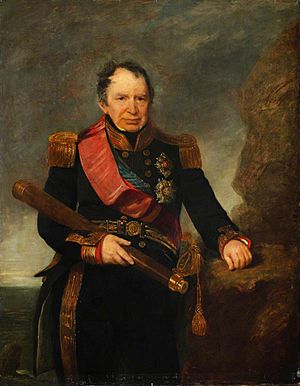Josias Rowley facts for kids
Quick facts for kids
Sir Josias Rowley, Bt
|
|
|---|---|

Admiral Sir Josias Rowley painted by Andrew Morton
|
|
| Born | 1765 |
| Died | 10 January 1842 |
| Allegiance | |
| Service/ |
|
| Rank | Admiral |
| Commands held | HMS Lark HMS Braave HMS Impérieuse HMS Raisonnable HMS Boadicea HMS America Cape of Good Hope Station Cork Station Mediterranean Fleet |
| Battles/wars | Napoleonic Wars |
| Awards | Knight Grand Cross of the Order of the Bath Knight Grand Cross of the Order of St Michael and St George Knight of the Military Order of Maria Theresa |
Admiral Sir Josias Rowley, 1st Baronet, was a brave British naval officer. He was born in 1765 and passed away on January 10, 1842. People often called him "The Sweeper of the Seas" because of his success in naval battles. He is most famous for leading the campaign that captured the French islands of Réunion and Mauritius in the Indian Ocean in 1810.
Contents
Early Life and Family
Josias Rowley was born in 1765 in County Leitrim, Ireland. He was the second son of Clotworthy Rowley and Letitia Campbell. His father was a lawyer and served as a Member of Parliament in Ireland. Josias came from a family with a strong naval background. His grandfather was Admiral of the Fleet Sir William Rowley, a very high-ranking admiral.
Josias joined the Royal Navy in 1778 when he was just 13 years old. He began his career on HMS Suffolk in the West Indies. His uncle, Sir Joshua Rowley, was his commander at that time. This early start helped him learn a lot about naval life.
Rising Through the Ranks
By 1795, at the age of 30, Josias was promoted to post captain. This meant he was in charge of his own ship. He commanded HMS Braave (a ship with 40 guns) near the Cape of Good Hope. Later, he commanded HMS Imperieuse (38 guns) in the East Indies. He also led HMS Raisonnable (64 guns) and took part in the Battle of Cape Finisterre in 1805.
Commander in the Indian Ocean
In 1808, Rowley became the commander-in-chief of the Cape of Good Hope Station. This was an important naval base. In 1809, as a commodore, he led a small group of ships near Mauritius. Working with British troops, he successfully attacked the island of Réunion.
Capturing Réunion and Mauritius
In March 1810, Rowley moved to HMS Boadicea (38 guns). He transported a larger landing force to Réunion and successfully captured the island. Meanwhile, another British force faced challenges from French ships near Mauritius. Rowley quickly responded and recaptured a British ship, HMS Africaine , that the French had taken. Finally, on December 3, 1810, Mauritius surrendered to the British forces.
Later Career and Honors
After his success in the Indian Ocean, Rowley was given command of HMS America (74 guns) in the Mediterranean. In December 1813, he was honored by being made a baronet, which is a special title. He was promoted to rear-admiral in 1814 and received the Knight Commander of the Bath award in 1815.
In 1815, at 50 years old, he sailed to the Mediterranean again with his flagship, Impregnable. In 1818, he became commander-in-chief of the Cork Station in Ireland. He was promoted to vice-admiral in 1825. In 1833, he became the commander-in-chief of the Mediterranean Fleet, one of the most important naval commands.
Death and Legacy
Sir Josias Rowley passed away on January 10, 1842, at his family home in Drumsna, Ireland. He was about 76 years old. He was buried and remembered at Annaduff Parish Church nearby. He never married and had no children to inherit his titles.
In Literature
The naval campaigns led by Sir Josias Rowley in 1809-1810 were used as the setting for a famous book. Author Patrick O'Brian wrote The Mauritius Command, which is the fourth book in his Aubrey–Maturin series. In the story, a fictional character named Captain Jack Aubrey takes the place of Rowley.
See also

